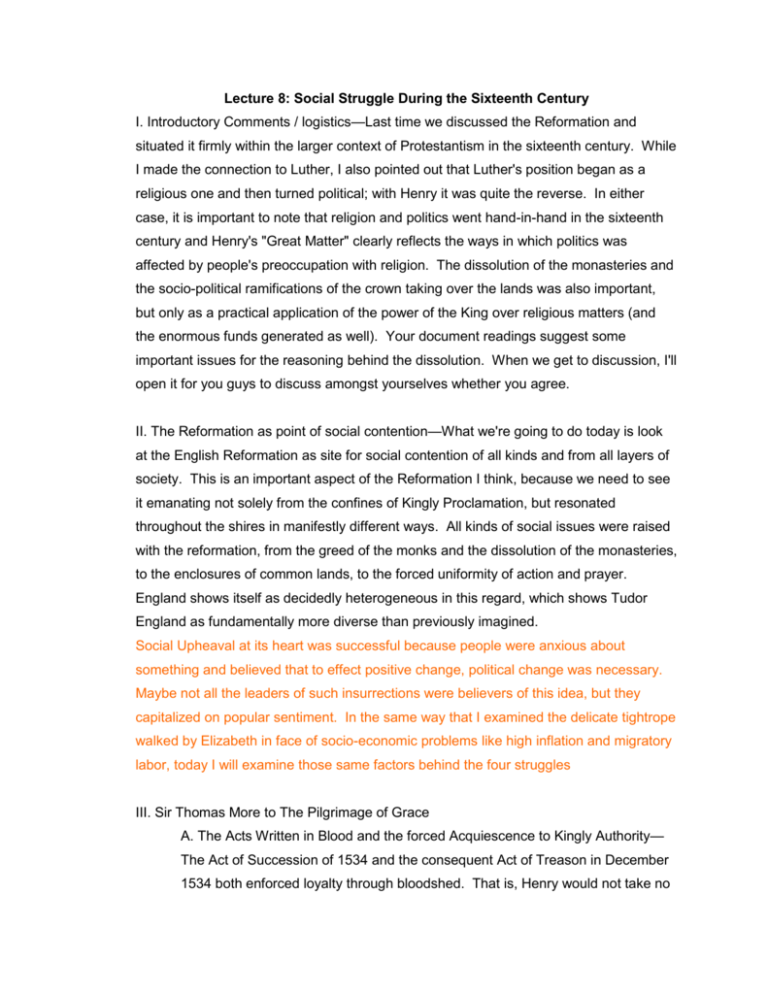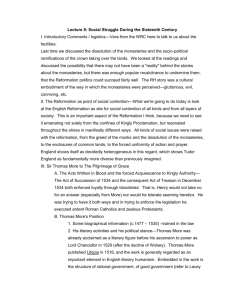reformation struggle
advertisement

Lecture 8: Social Struggle During the Sixteenth Century I. Introductory Comments / logistics—Last time we discussed the Reformation and situated it firmly within the larger context of Protestantism in the sixteenth century. While I made the connection to Luther, I also pointed out that Luther's position began as a religious one and then turned political; with Henry it was quite the reverse. In either case, it is important to note that religion and politics went hand-in-hand in the sixteenth century and Henry's "Great Matter" clearly reflects the ways in which politics was affected by people's preoccupation with religion. The dissolution of the monasteries and the socio-political ramifications of the crown taking over the lands was also important, but only as a practical application of the power of the King over religious matters (and the enormous funds generated as well). Your document readings suggest some important issues for the reasoning behind the dissolution. When we get to discussion, I'll open it for you guys to discuss amongst yourselves whether you agree. II. The Reformation as point of social contention—What we're going to do today is look at the English Reformation as site for social contention of all kinds and from all layers of society. This is an important aspect of the Reformation I think, because we need to see it emanating not solely from the confines of Kingly Proclamation, but resonated throughout the shires in manifestly different ways. All kinds of social issues were raised with the reformation, from the greed of the monks and the dissolution of the monasteries, to the enclosures of common lands, to the forced uniformity of action and prayer. England shows itself as decidedly heterogeneous in this regard, which shows Tudor England as fundamentally more diverse than previously imagined. Social Upheaval at its heart was successful because people were anxious about something and believed that to effect positive change, political change was necessary. Maybe not all the leaders of such insurrections were believers of this idea, but they capitalized on popular sentiment. In the same way that I examined the delicate tightrope walked by Elizabeth in face of socio-economic problems like high inflation and migratory labor, today I will examine those same factors behind the four struggles III. Sir Thomas More to The Pilgrimage of Grace A. The Acts Written in Blood and the forced Acquiescence to Kingly Authority— The Act of Succession of 1534 and the consequent Act of Treason in December 1534 both enforced loyalty through bloodshed. That is, Henry would not take no Sayegh lecture reformation struggle, page 2 for an answer (especially from More) nor would he tolerate seeming heretics. He was trying to have it both ways and in trying to enforce the legislation he executed ardent Roman Catholics and zealous Protestants. B. Thomas More's Position 1. Some biographical information (c.1477 – 1535) –trained in the law 2. His literary activities and his political stance—Thomas More was already acclaimed as a literary figure before his ascension to power as Lord Chancellor in 1529 (after the decline of Wolsey). Thomas More published Utopia in 1516, and the work is generally regarded as an important element in English literary humanism. Embedded in the work is the structure of rational government, of good government (refer to Lacey Smith's discussion on pages 103-104). As a work of humanism, it focused on the business of men—that humanity was responsible for constructing not only viable, but humane governments. 3. His separation from the King—the role of Richard Rich, backstabber extraordinaire As I mentioned, More ascended to the position of Lord Chancellor—a secular position that heard pleadings in the courts, etc. that was formerly held by Cardinal Wolsey—in 1529. For a long time, he held the king's ear, but he resigned from that position in 1532, because he could not support Henry's justification for separating from the Church. He was ratted out by Sir Richard Riche who was a political and religious chameleon. He changed his shape to fit the religious proclivities C. The Dissolution of the Monasteries and the Pilgrimage of Grace 1. Social friction in the North—the pilgrimage of Grace was a spontaneous uprising against the dissolution of the monasteries in North England. Troubled by the extent and ferocity of Cromwell's push to take over the houses and redistribute the lands, many people throughout the country opted to take politics in their own hands. Shortly before the PG, there was an uprising in Lincolnshire which very quickly dissolved in about two weeks. A conservative region, but housing nearly 25% of the dissolved monasteries, Lincolnshire and York believed that Cromwell was doing the country a disservice and taking it on a road to destruction. The gentry who ran the affair were very quickly compelled to quash the Sayegh lecture reformation struggle, page 3 uprising by the Duke of Suffolk. The King wrote a reply to the insurgents "rating them for their ignorant presumption and charging them to disperse" which they did (Williamson 145). 2. The role of Robert Aske—Robert Aske was a barrister in London from the area of York and led the revolt which broke out in late October 1536. He was also involved in the failed revolt in Lincolnshire. In all parts of the realm men's hearts much grudged with the suppression of abbeys, and the first fruits, by reason the same would be the destruction of the whole religion in England. And their especial great grudge is against the lord Cromwell This statement very clearly elaborates his distaste for the direction of the Reformation. Aske and members of the gentry, such as Lord Darcy, took over York and amassed an army of over 30,000. They argued that they had the right to petition the king, and that they were not working to remove the king. While the pilgrimage ended in a military settlement between Aske and the Duke of Norfolk, Aske was sent to London to explain himself, and while he was away, another uprising occurred in Cumberland and Westmoreland heading towards Yorkshire. Many in Parliament distrusted Aske's motives, and the King declared martial law, and under that guise initiated a massacre of rebels. At the same time, Aske was tried in London and executed for his crimes against the state. IV. Edward and Mary Tudor--two reigns, two dichotomous views A. Edward, the boy-king and his religious education by Katherine Parr. His mother was Jane Seymour who died of a botched caesarian just days after his birth. B. Developing a zealous Protestantism—as he was raised in the country, Edward came into contact with a zealous Protestantism. After his father's death, it is clear that Edward became even more "Protestant." While there remains some debate about who developed the Act of Uniformity as he was still quite young, it is important to note that Edward was intelligent and fully aware of his religious views. C. The Act of Uniformity (1549)—the act of uniformity was not fully accepted by the population. Before the Act, there were uprisings against the acts against enclosure in East Anglia (Suffolk and Norfolk), but it is the religious ferment in Sayegh lecture reformation struggle, page 4 1. the effects of the act in SW England—the instruction to accept only the book of common prayer resulted in spontaneous uprisings in Devon and Cornwall in the SW, which is often called the "Prayer Book Rebellion." Your reading for today has a vignette in which the affair began over the confiscation of a rosary, or prayer beads. While this is probably steeped in the folklore of the region after such a violent uprising in which many of the subjects were massacred, it is an important element in understanding historically the extent to which people first understood the Reformation and second accepted it. D. Struggle for the Crown--Lady Jane Grey and the Politics of Monarchy 1. The plan to get the Suffolks in power—the idea to put Lady Jane Grey in power only emerged because Edward was in power and became increasingly a zealot Protestant. Under the tutelage of his stepmother Katherine Parr, her husband Thomas Seymour and others, Edward grew into a strong-willed, albeit young, monarch. Jane Grey, a sixteen yearold, was married off and written into Edward's will as successor to the throne. At first, her male descendants were listed, but that changed. The idea of male descendants actively excluded Mary and Elizabeth from the throne 2. Mary's claim to the throne and support from East Anglia a. East Anglia quite protestant—Mary took haven in a decidedly Protestant area, which shows how strong the support for legitimacy was. She was, as I mentioned last time, perceived by much of England to be the rightful heir, and that Edward, or rather his ministers, falsely undermined Henry's will assuring the Tudor succession as Edward, Mary, Elizabeth. b. other areas of support as well—but Mary received other areas of support, too. In London, very few people said anything when Jane was announced as the new Queen, and in fact, one man declared that the Rightful Queen was Mary. c. Righteous indignation at circumventing inheritance—this represented not religious politics in England, but rather popular politics. What this means is that the crowd, or population, can Sayegh lecture reformation struggle, page 5 rally at points with a very strong consciousness. And very often, this can cross the popular sentiments of people's quotidian life. Mary's Accession and the reinstitution of hardline Catholicism—When Edward died in 1553, Lady Jane Grey ascended the throne for 9 days (we'll talk about her in two weeks). Mary, however, bitter over the treatment of her mother, and a staunch RC her entire life E. Wyatt's Rebellion—Above and beyond Jane Grey's hapless Queenship, popular resentment rose against Mary's betrothal to Philip II of Spain. InJanuary 1554, there were plans to get people not to overthrow her, but to reject her marriage to the Spaniard. The revolt really rose only in Kent (SE of London) under the leadership of Sir Thomas Wyatt who was caught and executed (?) when he reached London. Elizabeth was actually sent to the Tower for possible involvement in the Rebellion. The rebellion crushed, the two wed in July. As a result of Wyatt's rebellion, all potential rebelliousness was quashed by execution. Lady Jane Grey was executed, the Duke of Suffolk, Wyatt and about 200 of his followers. While Mary is described as having been saved by her courage—that is, she stated at St. James' Palaces in London—it was very clear that despite her call to arms for the alignment of London, that it was pretty divided. Wyatt very nearly got entry to the City and thus to the throne: "The rebellion had failed, but its expression of the public opinion had been impressive" (Williamson 229). V. Protestant v. Protestant--John Knox on Queen Elizabeth A. John Knox and Presbyterianism—the man who brought Calvinism to England. Calvinist theology is based on predestination, the idea that we are determined before we're born whether we're going to heaven or to hell. Those going to heaven are known as the "elect." If that's the case, why bother to do good works? If it's already determined that we'll go wherever, why not run amok? Good behavior is a sign, though of course not 100%, that you were one of the elect, and therefore, people worked harder. It's here that we get Weber's notion of the Protestant Work Ethic, because Calvinists strove to work harder, etc. This served as a form of social control. Calvinism was also very legalistic and Sayegh lecture reformation struggle, page 6 somewhat "Spartan" in that it eschewed finery. Knox was a Scottish theologian who encouraged people to flee to Europe to escape Mary's persecutions B. Attitudes towards Elizabeth—Knox definitely did not want Elizabeth at the helm of the country. For the main part, he believed that a woman in control would seed not only discontent, but anarchy. He wrote a pamphlet called The First Blast of the Trumpet against the Monstrous Regiment of Women on the year of her accession in which he wrote, "God hath revealed to some in this our age that it is more than a monster in nature that a woman should reign and bear empire above man" (Bassnett 106-7). This tract, according to Knox, was meant against the reign of Mary Stuart in Scotland as a wicked woman, not Elizabeth, but its timing in 1558 was enough to foster in Elizabeth concern about his motivations. C. Popular Manifestation of Puritan ideology—When Knox returned to Scotland from Geneva in 1559, his preaching instigation a popular uprising. In typical Calvinist ideology, it put forth the idea of a Protestant theocracy—that is, government ruled by religion. On the one hand, the rebels against the state, stopping short of saying they wanted to depose the Francophile Mary Queen of Scots, appealed to England (a Protestant country) for aid, but Elizabeth recognized the theocratic elements behind the rebellion. [note to self: find "Arran"]. The English did help in the Scottish Revolution (1543-1587) VI. Mary Queen of Scots and the Trouble with Family A. Francophile and Catholic—daughter of James V and Mary of Guise—sent to France to be educated. B. Problems in Scotland for Mary—Mary was consort of Francis II, found herself a widow in 1559 when he was killed in a jousting accident and at 17 returned back to Scotland. Mary had conveniently declared her role as Queen of Scots and as Queen Regnant of England, which led the Spanish Parliament to unite with Elizabeth to keep out the French (and RC) influence from Scotland. C. Problems in England for Mary—1569—the Great Northern Rebellion in which Northern Earls capitalized on Mary's presence in England to follow the RC excommunication order of Elizabeth (c. 1561?) in order to depose a heretical monarch. The result of the GNR was that Mary, second cousin to Elizabeth had to renounce her claim to the English throne, which she refused to do. She then Sayegh lecture reformation struggle, page 7 married her cousin Henry Stuart, Lord Darnley and had a son—the future James VI. The murder of her lover then her husband then running off with her husband's murderer led to her forced abduction D. "House Arrest" and Execution—Mary was under scrutiny by Elizabeth not only for her indiscreet behavior—she and Elizabeth are often juxtaposed historically. But her refusal to renounce any claims to the throne made Elizabeth wary of her cousin. This was realized in the Babington Plot in which Mary was personally involved. It was not simply people acting in her name; SHE was working with the Spanish to assert her control over the throne. Many of the arguments used to justify this plot rested on the Queen's supposed illegitimacy when Henry made Elizabeth and Mary (Tudor) unable to inherit (at first) VII. Concluding Comments / discussion— Now we're going to talk about the readings for today. The Robin Hood article, combined with the dissolution documents show that while there may not have been a "reality" behind the stories about the monasteries, there was enough popular recalcitrance to undermine them, that the Reformation politics could succeed fairly well. The RH story was a cultural embodiment of the way in which the monasteries were perceived—gluttonous, evil, conniving, etc. Further, despite efforts at making the Reformation complete, Henry's legacy religiously was incomplete. The second article for today (Norman Jones) suggests that context is crucial in understanding the Reformation—that it was shaped by who you were, when you were and where you were. There was no consensus, as the very first line points out, and people read the Reformation, understood it or rejected it based on their age and their personal circumstances. We're going to examine both of those articles in more detail now. next week we're going watch Man for All Seasons and see a dramatic interpretation of some of the politics of the age. Especially poignant will be the relationship between Sir Thomas More and Richard Rich…








